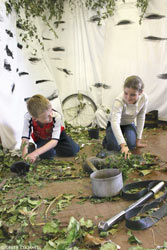Professional development: Be creative!
Add to My Folder
You want to be more spontaneous in your teaching. There is never enough time. There is too rigid a structure to allow you to be flexible in your planning. Do any of these ring bells for you? Kathy Alcock provides ten approaches to help bring creativity into the classroom

Letting children help you make exciting displays is a great way to facilitate their learning
- As you plan, identify the main learning intention but leave a space for adding in more during or after the lesson to encourage spontaneity. By asking the children what they have learned, and by noting down their responses, you may be amazed by the results. Check how many children are in agreement by putting a coloured ‘blob’ by their names in your assessment record against that statement.
- Whenever possible, after introducing a topic ask your class what they already know but even more importantly, what they do not know and any questions that they have. Allow the children to generate their own enquiry lines, and leave time within your lesson structure for this enquiry to be followed through. If another lesson has to be postponed, so what? This is effective teaching. Cutting off children when they are totally engrossed may be detrimental to their learning.
- Build a display over a week. Clear the board on a Friday and tell the children what you are covering during the next week. Ask them to think what the display could portray and to collect resources. Encourage them to think laterally and creatively. You may need to model this yourself. Allow a small group of children to take charge of the display, which can be changed regularly to reflect ongoing learning. Use the displayed material in your teaching.
- Bring in interesting artefacts, flowers, plants, pictures, and so on to enliven your classroom. Other adults who work with you, or parents/carers, may be prepared to assist with this. Don’t make the classroom too busy or fussy, but variety and change can help to promote creativity and learning.
- Try using music for entry or exit to the classroom. Introduce styles that may be new to the children or that reflect their own preferences. Let the children take turns in bringing in the CDs or tapes. You may be able to allow them to work with music playing through personal stereos, although this would have to be checked with senior management first. Many children work at home this way, so why not at school?
- Invite the children to plan the layout of the classroom. As part of a lesson to practise the concept of scale, use a drawing of the room (you may find there is one on the plans of the school). Instruct the children on how to make the shapes of the desks and chairs to the same scale. Get them to design a layout, then move the furniture to reflect that design. This will not only be a fun activity, but could be effective learning for the future.
- Changing your appearance in some way may inject new life and inspire children to be more creative. You are a key feature in the classroom, so a new hairstyle, clothing makeover, even welcoming the children in a completely new way, can enliven the atmosphere for learning.
Member-only content
Scholastic Resource Bank: Primary - join today!
- Over 6,000 primary activities, lesson ideas and resources
- Perfect for anyone working with children from 5 to 11 years old
- Unlimited access from just £1.25 per month
Already a member? Sign in below.
Published 30 May 2008
Reviews
You need to be signed in to place a review.